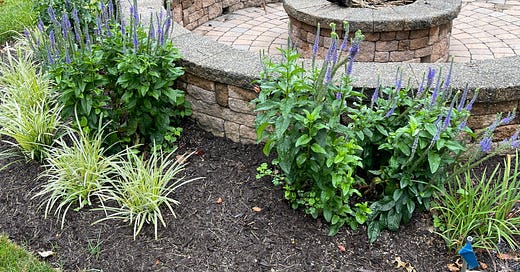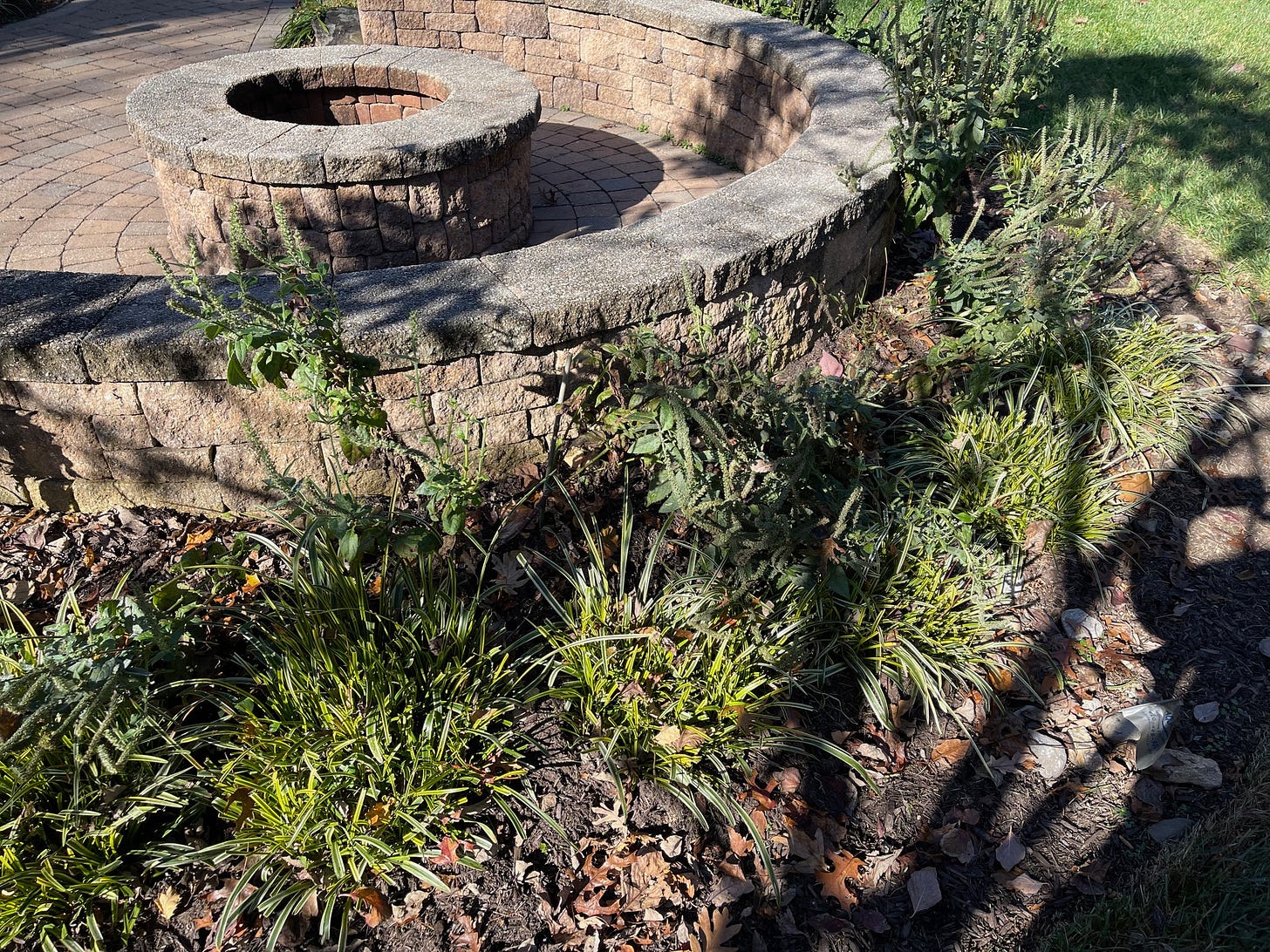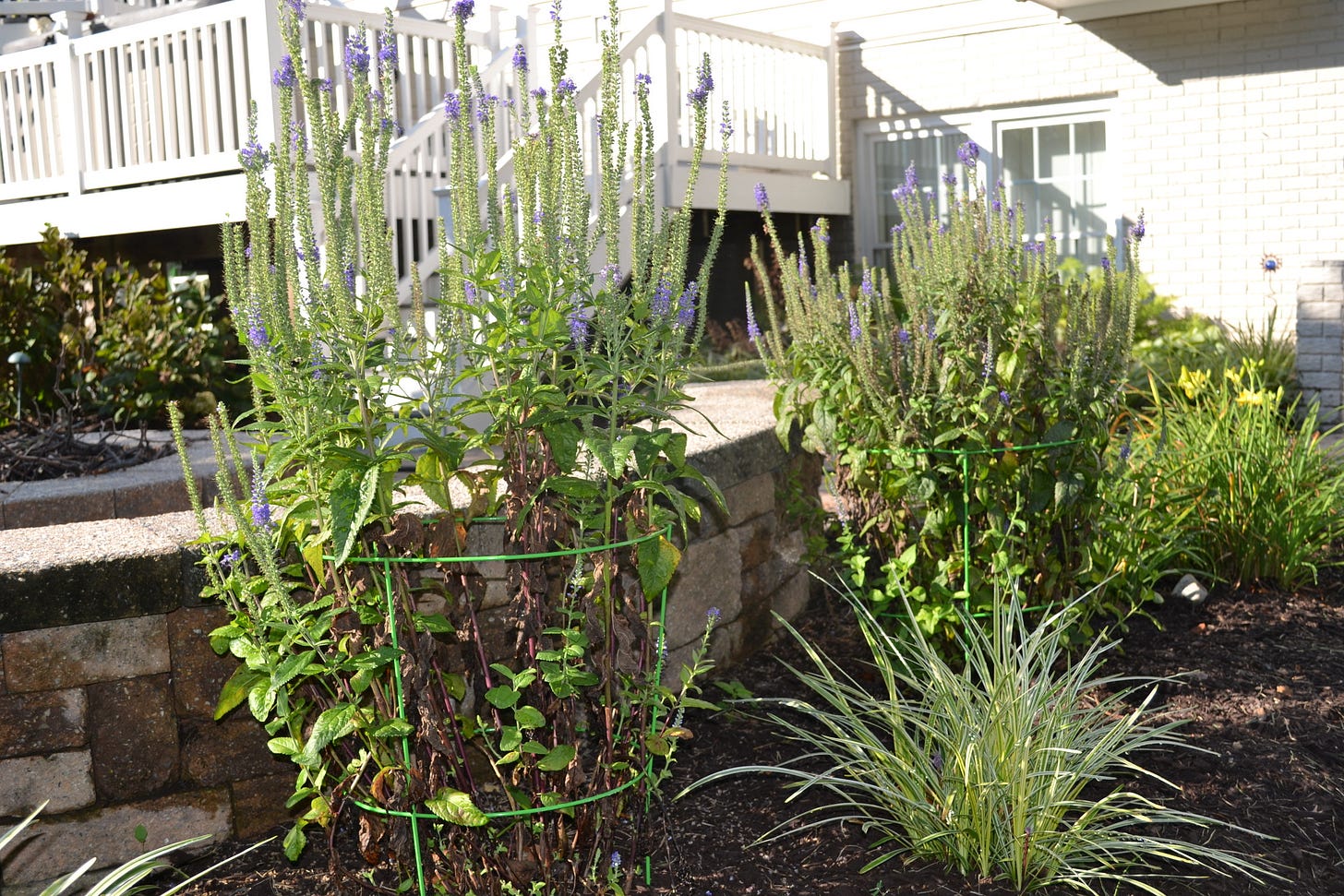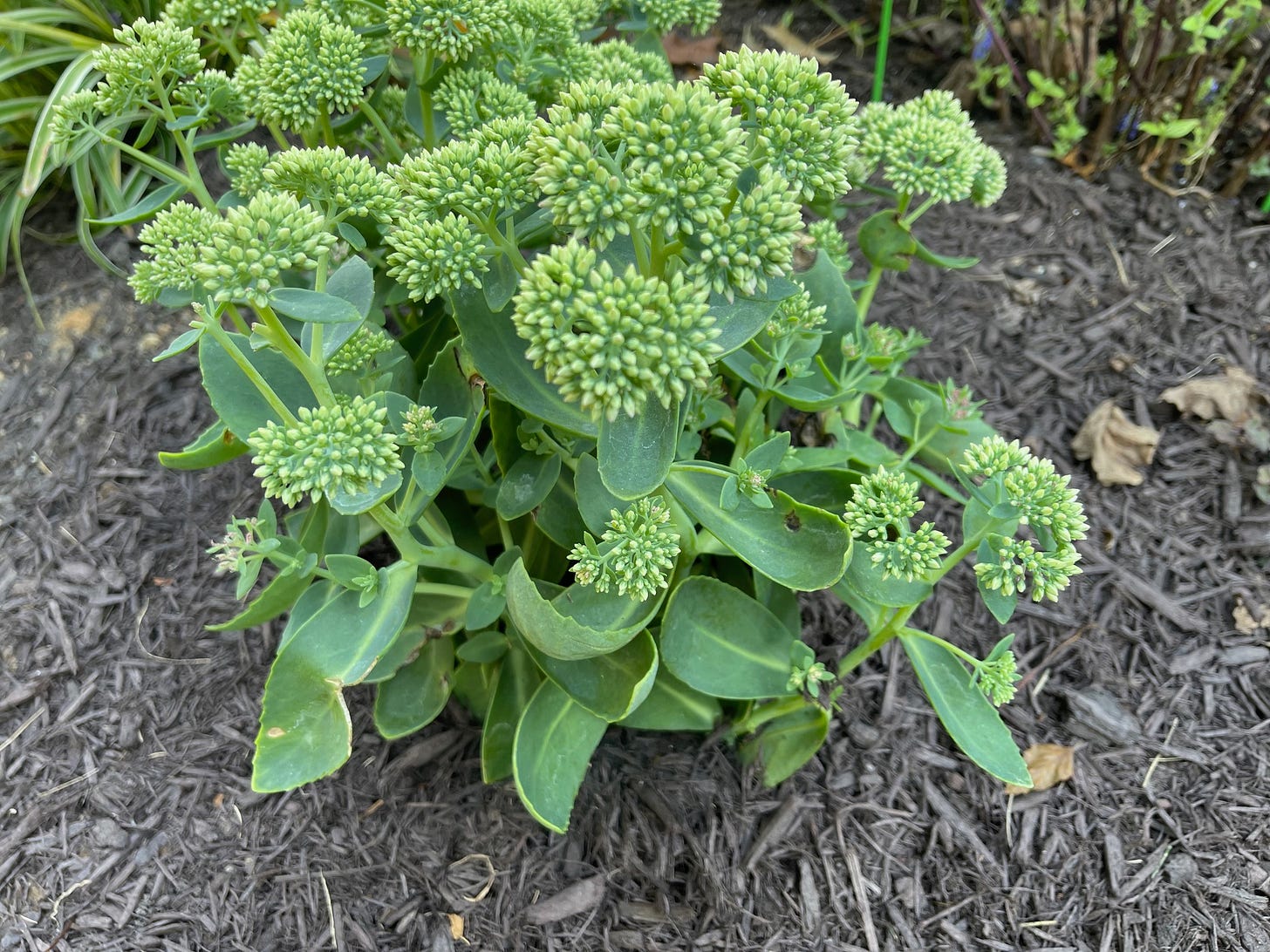The Fire Pit Bed
A great place to hang out with the Blue Veronica if you don’t mind the bees… I mean the pollinators. Is it possible the daffodils will bloom this spring?
I always thought the fire pit bed would be a highlight of the entire garden because it is a very short walk from the middle of the patio where we entertain guests, and because it is functional. There is nowhere else in the garden where you can sit on a wall, stare at a beautiful bonfire, and eat s’mores for dessert after a nice dinner.
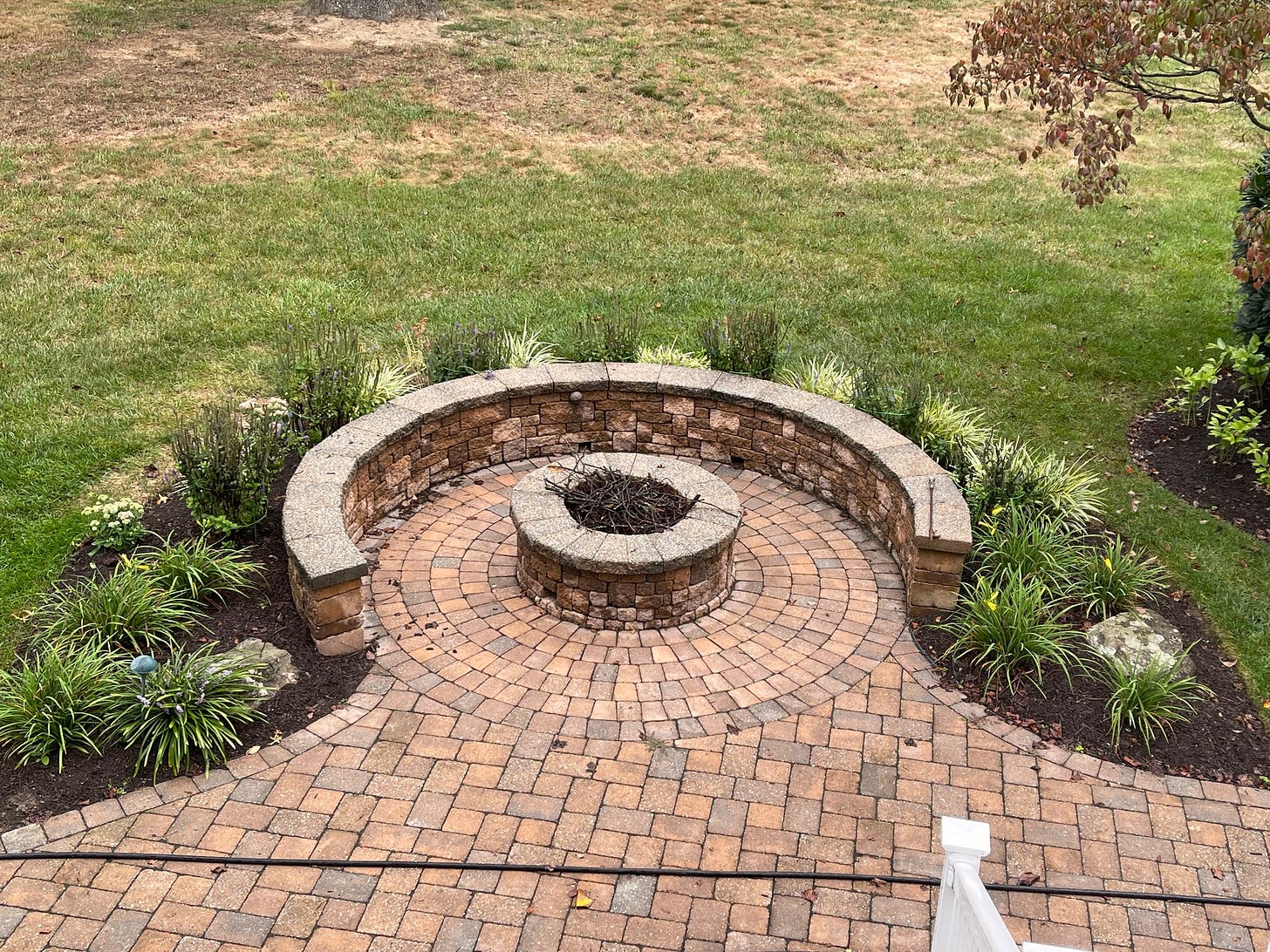
Today the big story in the fire pit bed is the Sunny Border Blue Veronica, otherwise known as Speedwell. When we were designing this bed in 2022, the concern was how much sun the fire pit bed would get because it is partially shaded by a large dogwood tree. We ended up installing seven blue veronica plants evenly around the fire pit and I was hoping that the flowers, which look like purple spikes, would have enough sun to stand proudly above the sitting wall around the fire pit.
The results in 2022 were disappointing. The plants grew nicely in the spring and threw off long purple flowers, but as the season went on the plants began to flop, with stems sprawling wildly along the ground and flower spikes going in every direction. After considering this untidy situation I thought I would give the plants another try last year. My plan was to cut them back to the ground in late fall 2022 and provide some support for the plants as they grew back last summer. And so I entered the world of tomato stakes, a wonderful garden aid for supporting plants that can be obtained inexpensively at any garden store where they are usually purchased by, you guessed it, folks growing tomatoes. I purchased 10 of them and used seven to stake up my blue veronica early in the spring. Last summer and into the fall the purple flower spikes stood proudly vertical, and the effect was as stunning as I’d originally hoped.
One other quick note about blue veronica. The bees love them. I know as a gardener I’m supposed to love and appreciate bees and the job they do pollenating my plants. Believe me, I’m appreciative. But when I’m reaching underneath the plants to get some hard-to-reach weeds, and the buzzing from the bees reaches a certain volume, I’m not the calm gardener in touch with nature that I aspire to be. I would describe my reaction as somewhere between concerned and panic-stricken. (See more notes on this in last week’s post, Spiderwebs, found in the archives with some other great garden literature.) Now that the plants are doing well, I’m afraid to have guests, especially younger guests, sitting on the wall surrounding the fire pit eagerly eating their s’mores. Considering the number of bees hanging around the plants, dessert could turn out to be a little more exciting than my guests bargained for, especially if the smoke from the fire pit makes the bees angry. I must say, when the pit lights up and really gets going, it is quite a sight. Just don’t get downwind of the flames because the heat and smoke can suffocate if you are at the wrong place at the wrong time. Be prepared to wash your clothes afterwards.
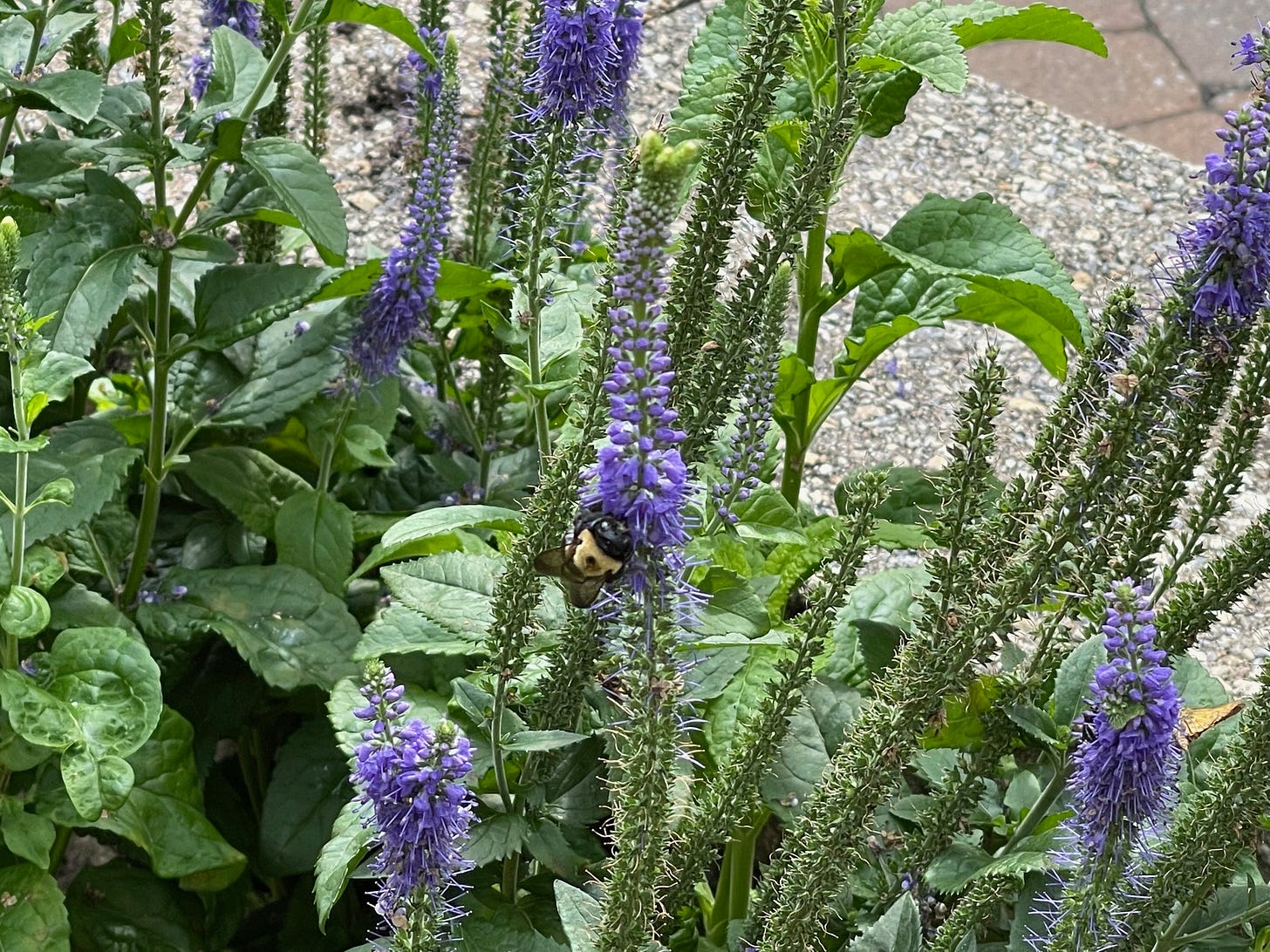
The ring of blue veronica is matched by a concentric ring of variegated liriope. These plants were included in the 2006 landscape design and might have been part of the original builder’s landscape. They are as hardy as any plants in the garden. The tall light and dark green striped leaves of variegated liriope make for an interesting contrast the entire season. It’s easy to forget just how beautiful liriope look when they flower in the fall. The spikey blue flowers that burst from the light and dark green leaves are always a surprise come August and September.
Once again, I marvel at how well plants did without any meddling from me over the past seventeen years. I’ll probably divide these plants next spring, although I’m not looking forward to digging them up. They’ve been there for a long time and their roots are well established. I know from experience that it’s really difficult to dig them out. That project will make for a couple of very long days.
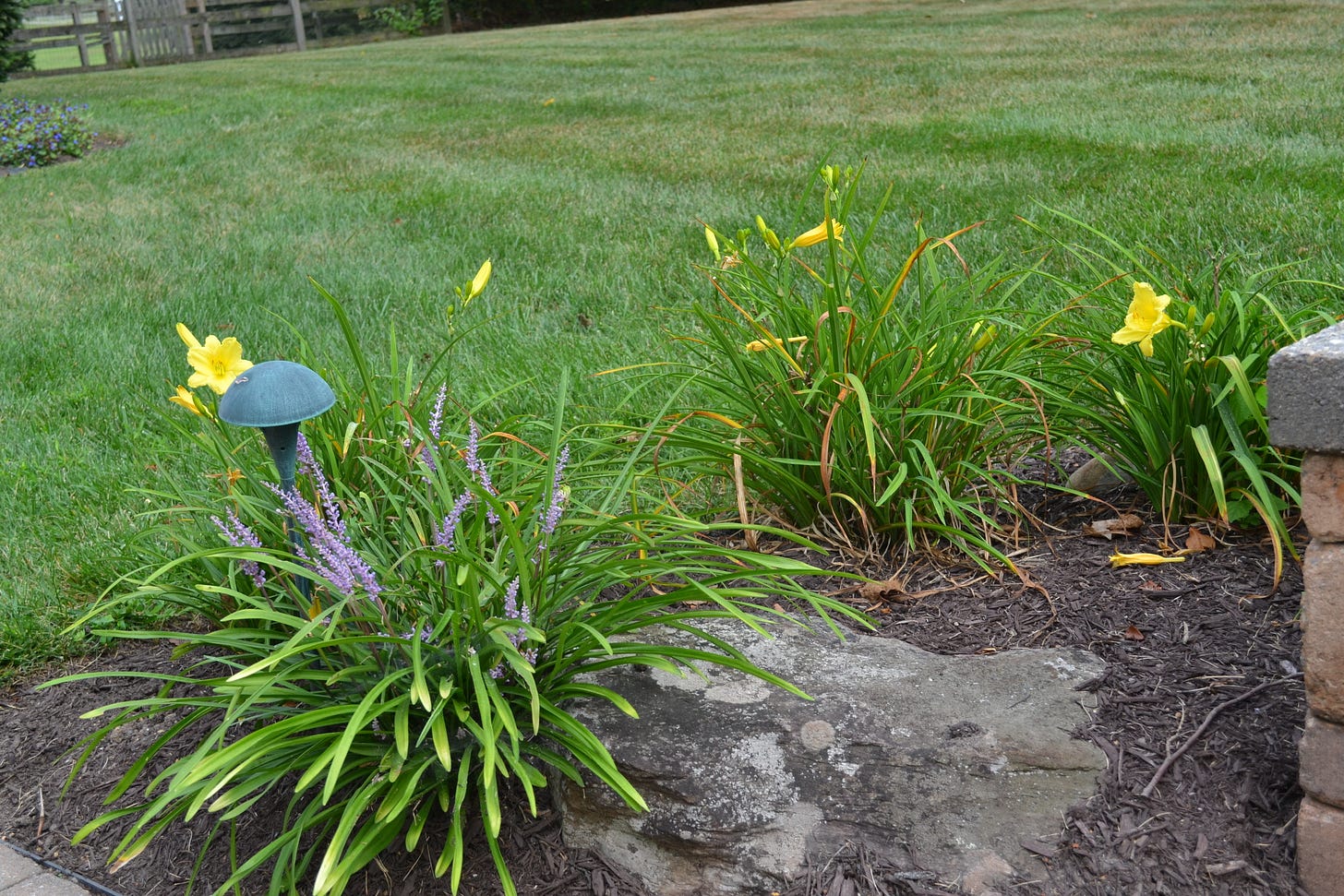
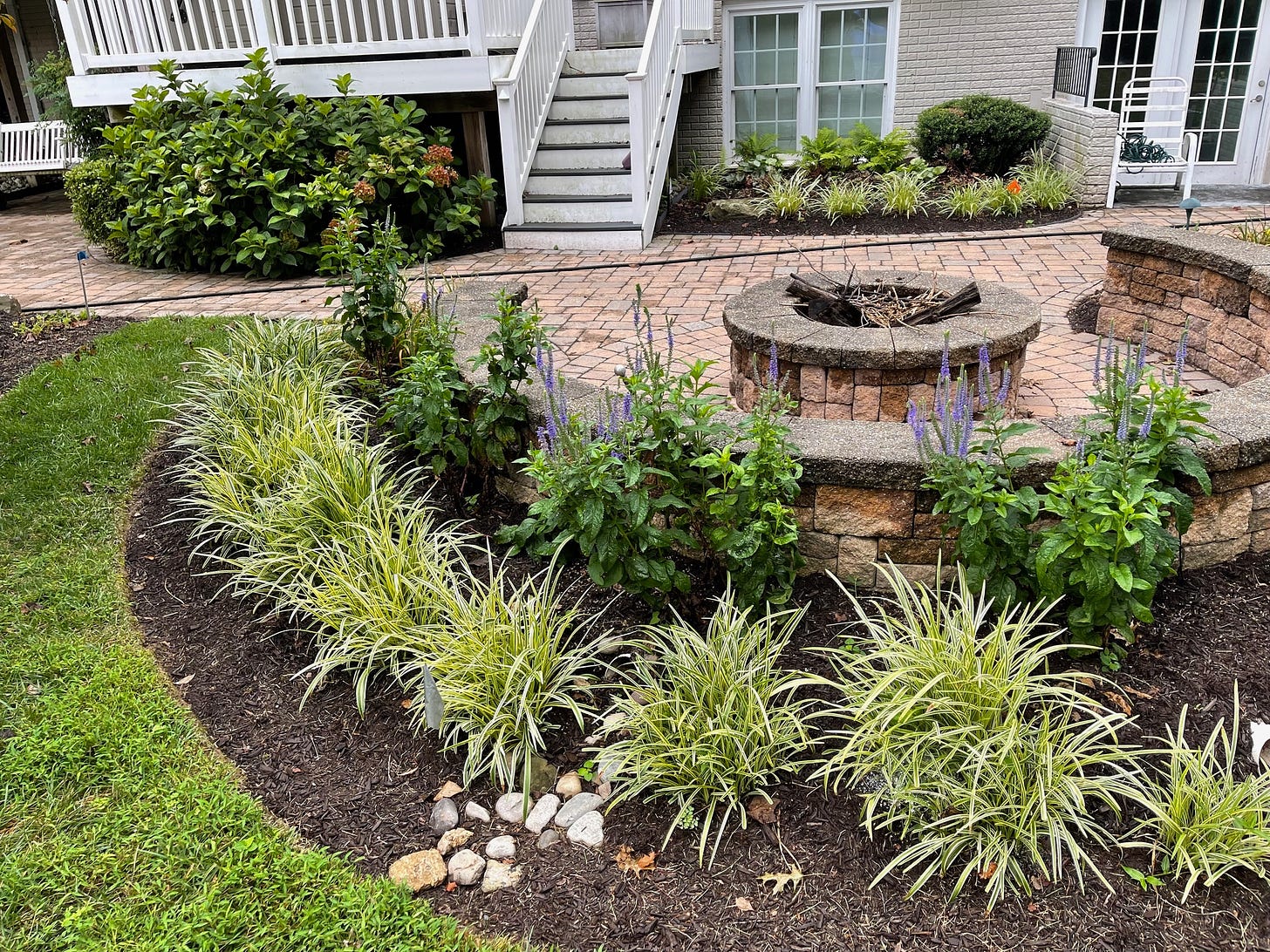
Late last summer I added autumn joy sedum to the bed. Two of the plants are transplants from the sun bed, where birds found great joy in eating the sedum leaves. I transplanted them to the sunniest part of the fire pit bed in hopes the birds wouldn’t find them. They did so well that I couldn’t resist buying two smaller sedums on sale at Home Depot and planting them as well. What fun to watch all four plants do well and turn a beautiful pink color through the fall season. I can’t wait to see how the sedum shredded by the birds fare next spring. They look a little naked at the moment. It would be great if they return just as robust and healthy as when I bought them home from the nursery.
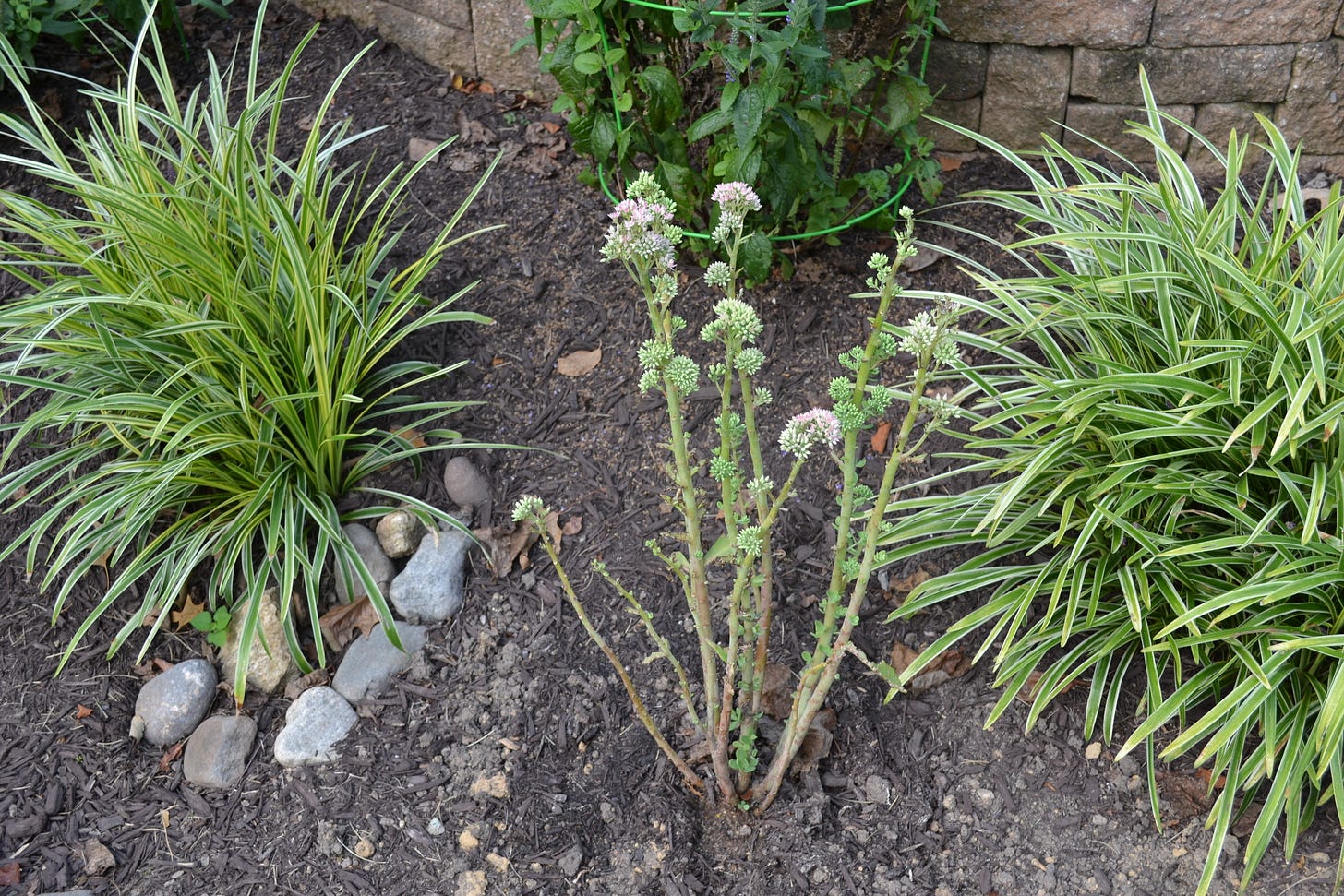
The last plants in the bed are the daylilies, more holdovers from the original 2006 garden design. Like the other plants from the original design, the daylilies seem strong and healthy, and they flower throughout the entire season. I watched some videos this year about how to carefully deadhead the flowers after they bloom and how to cut the seed pods all the way back, so you get more blossoms late in the season. It seemed to work. Other than paying a little attention to them throughout the year, my only plan for the daylilies is to enjoy them next year. The two different shades of yellow flowers look great as a contrast with the other flowers in the bed.
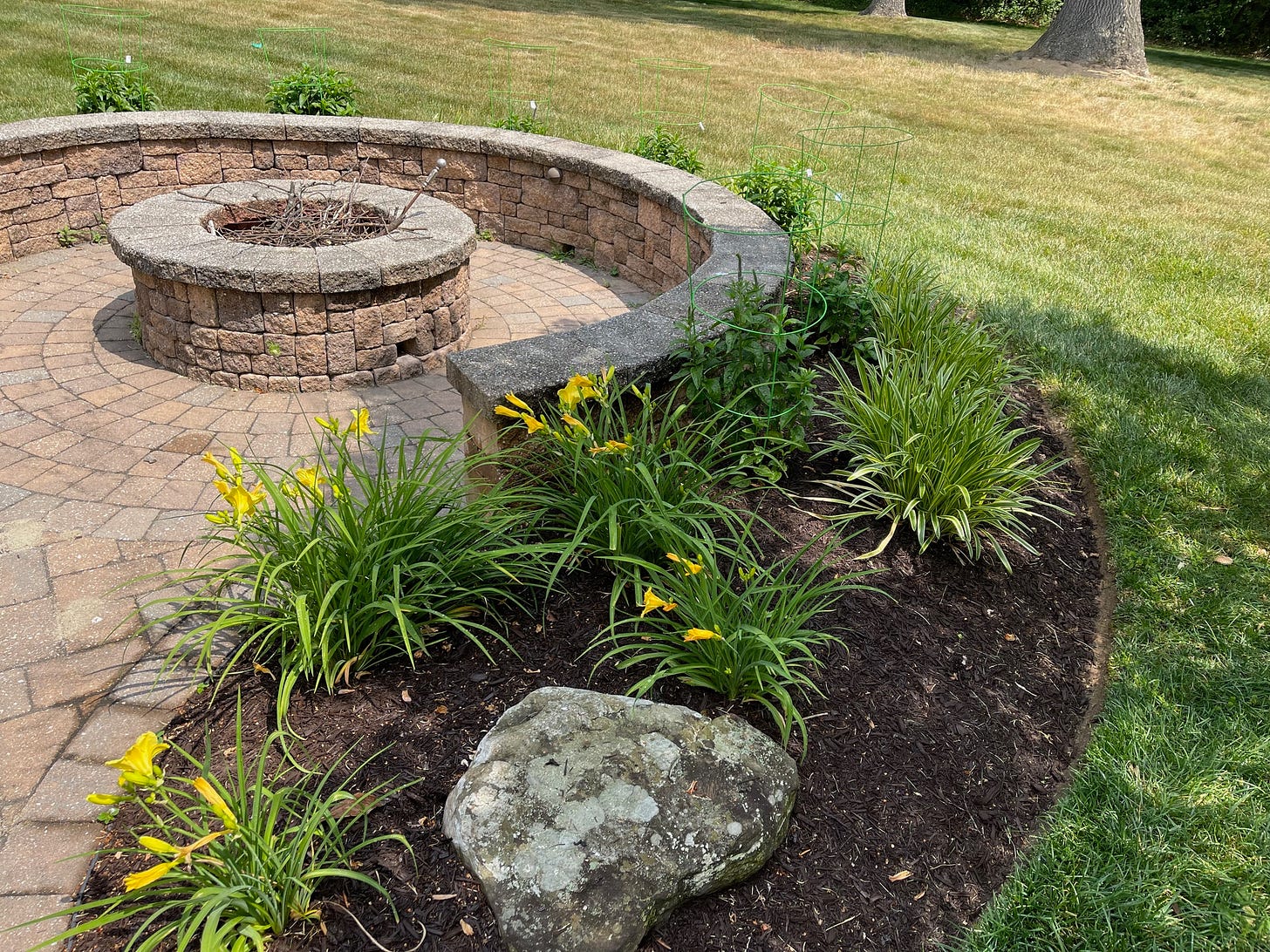
I did have one earth-shatteringly different idea for the bed last fall. I planted 50 daffodil bulbs in late September and hope for some early spring color in the bed, especially since the veronica and daylilies are late spring and summer bloomers. I’ve been watching videos on how to plant bulbs, and I always laugh when I see how easy it is to plant in perfect soil. But in this case, the soil is mostly clay. I had to amend the clay with compost and topsoil, or in some places replace the clay altogether, dumping it in the woods behind the house. My research on what kind of bulbs to plant suggests the squirrels are more likely to leave daffodils alone. So far, the squirrels haven’t dug up the bulbs, so I’ll be curious to see if any daffodils make an appearance next spring. I purchased renewing daffodils that sound a lot like perennials to me. They’re supposed to come back every year and spread out in the bed, so we’ll see. The only plant I’ve installed that spread out as advertised was creeping jenny in the astilbe bed. Forgive me if I’m a little skeptical that bulbils, whatever they are, will spread when the soil has so much clay just under the surface. Once again, my lack of patience is killing me.
This really is a spectacular place in the garden when everything is blooming at the same time. In late summer you get the vertical flowers from the blue veronica, the yellow flowers from the day lilies, and the purple flowers from the liriope in a cascade of color. Combine the plants with the unusual hardscape of the pavers and the fire pit, and you have a nice place to visit if you’re looking to sit down and hang out in the garden for a few minutes. Just keep an eye out for the bees.
As you can tell, because of the clay soil in my garden, planting new perennials is a challenge. Next week I’ll give you step-by-step instructions for how to plant a new plant. You will be stunned by the expert instruction you’ll get for free so don’t miss it. After that, we’ll move on to the waterfall bed.

